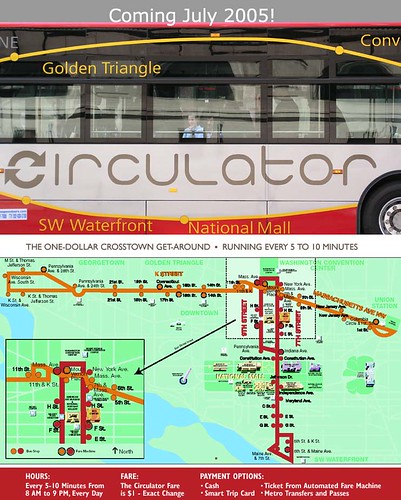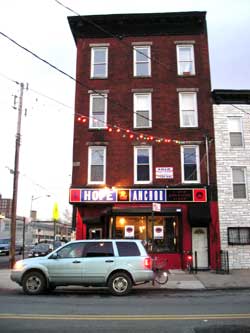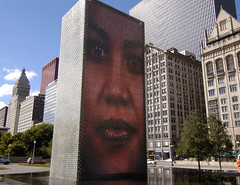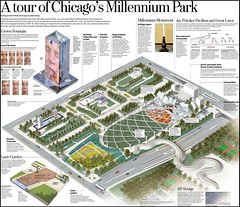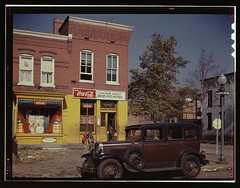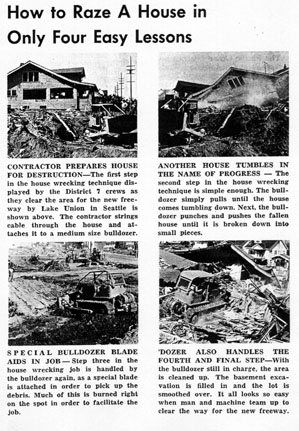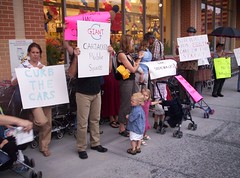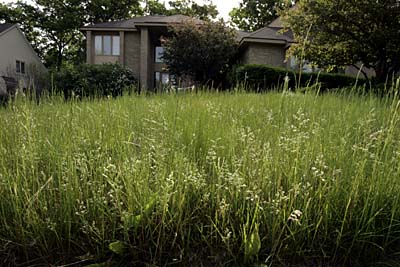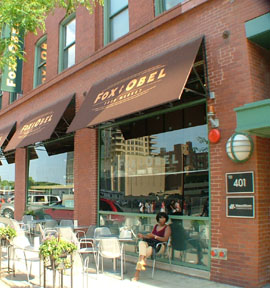Title 24 of the DC Code of Municipal Regulations is about "Public Space and Safety." Unfortunately, that section of the DCMR is not online at the DCMR website (which is listed in the DC section of links in the right sidebar).
Perusing the chapter, it could probably be argued that alley monitoring cameras wouldn't be a violation. But then, I am not a lawyer. Even so, that slippery slope does concern me, although I support speed cameras and red light cameras as it is. And one could argue with me because the definition of what "closed circuit television" is covers everything, if it is a live link -- "Closed-Circuit Television--Any live video link that is electronically received into the SOCC. [*11448]"
But because these cameras do not provide a live link, they probably would not be out of compliance with the regulation. Would they be covered by the regulation at all?
If any monitoring devices are supposed to be covered by this chapter, then alley monitoring wouldn't qualify right now in terms of purpose as outlined in 2500.2 and 2500.3
Before getting into the fascinating regulations, check out this article about the use of such cameras in San Jose, California "
Smile You're on Candid Camera" or
these photos-case studies and
this BBC article from the UK.
Plus according to the DC "Business Resource Center" e-newsletter, such a camera was tested in Adams-Morgan in 2003--see "
DC launches major anti-graffiti effort."
___________________________________________________________From 24DCMR
2500 PURPOSE2500.1 The Metropolitan Police Department (MPD) has employed an internal network of closed circuit televisions (CCTV) within the Synchronized Operations Command Complex (SOCC) that are highly secured and protected against unauthorized access.
2500.2 MPD's CCTV system is generally intended to be used: (1) to help manage public resources during major public events and demonstrations; and (2) to coordinate traffic control on an as needed basis.
2500.3 In addition to the purposes listed in 2500.2, the CCTV system may also be employed in exigent circumstances for the duration of the exigent event or circumstance.
2501 POLICY2501.1 MPD shall comply with all federal and District law applicable to the use of CCTV cameras in public space.
2501.2 The technology will not be used to replace current policing techniques. [*11444]
2501.3 Under no circumstances shall the CCTV systems be used for the purpose of infringing upon First Amendment rights.
2501.4 Operators of the CCTV systems shall not target/observe individuals solely because of their race, gender, ethnicity, sexual orientation, disability or other classifications protected by law.
2501.5 CCTV systems shall be used to observe locations that are in public view and where there is no reasonable expectation of privacy.
2501.6 MPD shall not use audio in conjunction with the CCTV unless appropriate court orders are obtained.
2501.7 MPD is authorized to enter into agreements with public entities to access their external video feeds for the purposes established in 2500.
2501.8 MPD is authorized to enter into agreements with private entities to access their external video feeds for discrete periods and only in exigent circumstances.
2501.9 MPD shall abide by these regulations if it receives CCTV feeds from another agency, jurisdiction, or entity.
2501.10 Until legislation is enacted authorizing the use of CCTV for other purposes such as general crime deterrence in non-exigent circumstances, additional permanent cameras will only be installed after public notification has been provided and only in locations that will advance the purposes defined in section 2500 of these regulations.
2502 PUBLIC NOTIFICATION 2502.1 Except under exigent circumstances and/or when the CCTV systems are deployed pursuant to a court order, the Chief of Police shall provide public notice of MPD's intention to deploy a camera.
2502.2 Public notice shall include the general capabilities of CCTV systems, their use in departmental operations, and the duration of the deployment. Public notice will also identify the viewing area, but not necessarily the precise location of the camera. The precise location of a camera may be disclosed if the Chief of Police determines that disclosure will not undermine the security of the camera and the efficacy of the deployment.
2502.3 The public shall have thirty (30) days to submit comments regarding a proposed deployment to the Chief of Police. The public may submit comments to the Chief of Police at any time regarding a particular camera deployment or the CCTV system in general. [*11445]
2502.4 The Chief of Police shall consider the comments submitted by the public in determining whether to go forward with deployment of the camera. The Chief of Police will provide public notice of his decision and provide an explanation.
2502.5 In exigent circumstances, the Chief of Police is authorized to deploy cameras without first consulting or soliciting comments from the public. After the conclusion of the exigent circumstance, the camera shall be turned off immediately. As soon as feasible after the conclusion of the exigent circumstance, the Chief of Police shall have the camera removed. The Chief of Police will provide post-deployment public notification of any camera deployed under this provision.
2502.6 When cameras are deployed pursuant to a court order, neither pre nor post-deployment notification is required.
2502.7 MPD will post and maintain signage indicating the presence of CCTV systems in the District of Columbia.
2502.8 On a semi-annual basis, MPD will provide updates on the CCTV system at community meetings to be announced to the public.
2502.9 MPD will provide information about the CCTV system and its usage in its Annual Report. The information shall include the viewing area of cameras, periods of activation and/or recording and the purposes of activation and recording, disposition of any recordings, and an evaluation of whether the camera achieved the purposes stated in section 2500. The MPD shall not include any information pertaining to cameras deployed pursuant to a court order or deployed as part of an on-going criminal investigation.
2503 OPERATOR CERTIFICATION2503.1 Only certified operators shall operate the CCTV system.
2503.2 All operators of the CCTV systems shall sign a certification that they have read and understand the CCTV regulations and acknowledge the potential criminal and/or administrative sanctions for unauthorized use or misuse of the CCTV systems.
2503.3 Anyone who engages in the unauthorized use or misuse of CCTV systems shall be subject to criminal prosecution and/or administrative sanctions, including termination. The administrative sanctions will depend on the severity of the infraction and shall be taken in accordance with MPD's Disciplinary Procedures and Policies General Order and/or the adverse and corrective action procedures as provided in the District Personnel Manual. [*11446]
2504 ACTIVATION AND USAGE2504.1 Except for demonstration purposes and exigent circumstances, members of MPD shall receive written authorization from the Chief of Police prior to activating the CCTV system.
2504.2 Every system activation shall be documented. SOCC personnel will enter activation information, including the disposition of any observed incidents, into the running resume of the daily SOCC report, including a copy of any written authorizations pertaining to each activation, the name(s) of any person(s) activating the system, a general description of the activity being monitored, and documentation of when activation began and ended.
2504.3 An official of the rank of Lieutenant or above shall be present in the SOCC at all times, and shall supervise and monitor CCTV activities conducted in the SOCC.
2504.4 Operators of CCTV systems shall not focus on hand bills, fliers, etc., being distributed or carried pursuant to First Amendment rights.
2504.5 Operators will dispatch resources as needed.
2505 AUTHORIZATION TO RECORD AND RETAIN RECORDINGS2505.1 Except in exigent circumstances or when recording is being done pursuant to a court order, the Chief of Police shall issue written authorization prior to recording any CCTV feed.
2505.2 Every recording shall be documented. The record shall include a copy of any written authorizations pertaining to each period of recording, the name(s) of any person(s) recording, a general description of the activity being recorded, and documentation as to when the recording began and ended.
2505.3 When recordings are made in exigent circumstances, the recording documentation shall also include a description of the exigency that gave rise to the need to record without prior written authorization.
2505.4 All recorded CCTV footage shall be maintained and secured by the official in command of the SOCC.
2505.5 Video recordings shall be indexed, stored, and maintained for 10 business days after which time they will be recorded over or destroyed.
2505.6 Recordings may be retained beyond 10 business days because the recordings contain evidence of criminal activity, because the recordings capture an occurrence that may subject MPD to civil liability, or because the recording will be used for training purposes. Recordings that contain evidence of criminal activity or recordings that [*11447] capture an occurrence that may subject MPD to civil liability shall be maintained to final case disposition.
2505.7 The Chief of Police must provide, in writing, any decision to retain any recording beyond 10 business days.
2505.8 Decisions to retain recordings beyond 10 business days must include the purpose of the retention, the nature of the recording, and length of time for the retention. Retention of recordings for training purposes must additionally include a written description of the training purpose to be served by the recording as well as a description of the recording's unique suitability for the training purpose.
2505.9 Recordings retained for training purposes may only be retained as long as they are actively used for training purposes.
2505.10 Recordings retained for criminal or civil purposes shall be secured as evidence, and access to the recordings shall be appropriately limited and documented.
2505.11 SOCC staff shall maintain a video catalog of all tapes held beyond 10 days, including a copy of any written authorizations pertaining to each activation/recording, the name(s) of any person(s) doing any recording, a general description of each activation/recording, and documentation as to when activation/recording began and ended.
2506 MAINTENANCE2506.1 MPD shall be responsible for the safekeeping, maintenance and servicing of MPD equipment (e.g., cameras, cables, monitors, recorders, etc.).
2507 AUDITS2507.1 MPD's Office of Professional Responsibility will conduct periodic audits, at least quarterly, to ensure compliance with these regulations.
2507.2 The audits conducted pursuant to 2507.1 shall be provided to the Mayor and the Council of the District of Columbia.
2599 DEFINITIONS 2599.1 When used in this chapter, the following words and phrases shall have the meanings ascribed:
Closed-Circuit Television--Any live video link that is electronically received into the SOCC. [*11448]
Demonstration - A temporary presentation of the capacity of the SOCC to visitors of the MPD.
Exigent Circumstances--Unanticipated situations that threaten the immediate safety of individuals or property within the District of Columbia.
External Video Feeds--Any video link received in the SOCC on a live basis from a source other than MPD.
Public Entities--District of Columbia or Federal agencies.
Public notice--Shall at a minimum include, but is not limited to, publication in the D.C. Register, posting on the MPD website, written notice to the relevant Council Member, written notice to the relevant ANC Commissioner, and issuance of a press release.
 Gettysburg Battlefield. Photo: New York Times.
Gettysburg Battlefield. Photo: New York Times.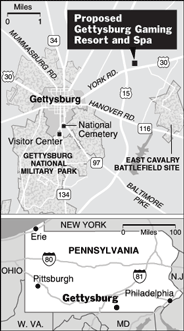 Local residents say that the battlefield is actually the whole town. Graphic: New York Times.
Local residents say that the battlefield is actually the whole town. Graphic: New York Times. Segway in Annapolis, Maryland. Photo: Washington Post.
Segway in Annapolis, Maryland. Photo: Washington Post.




